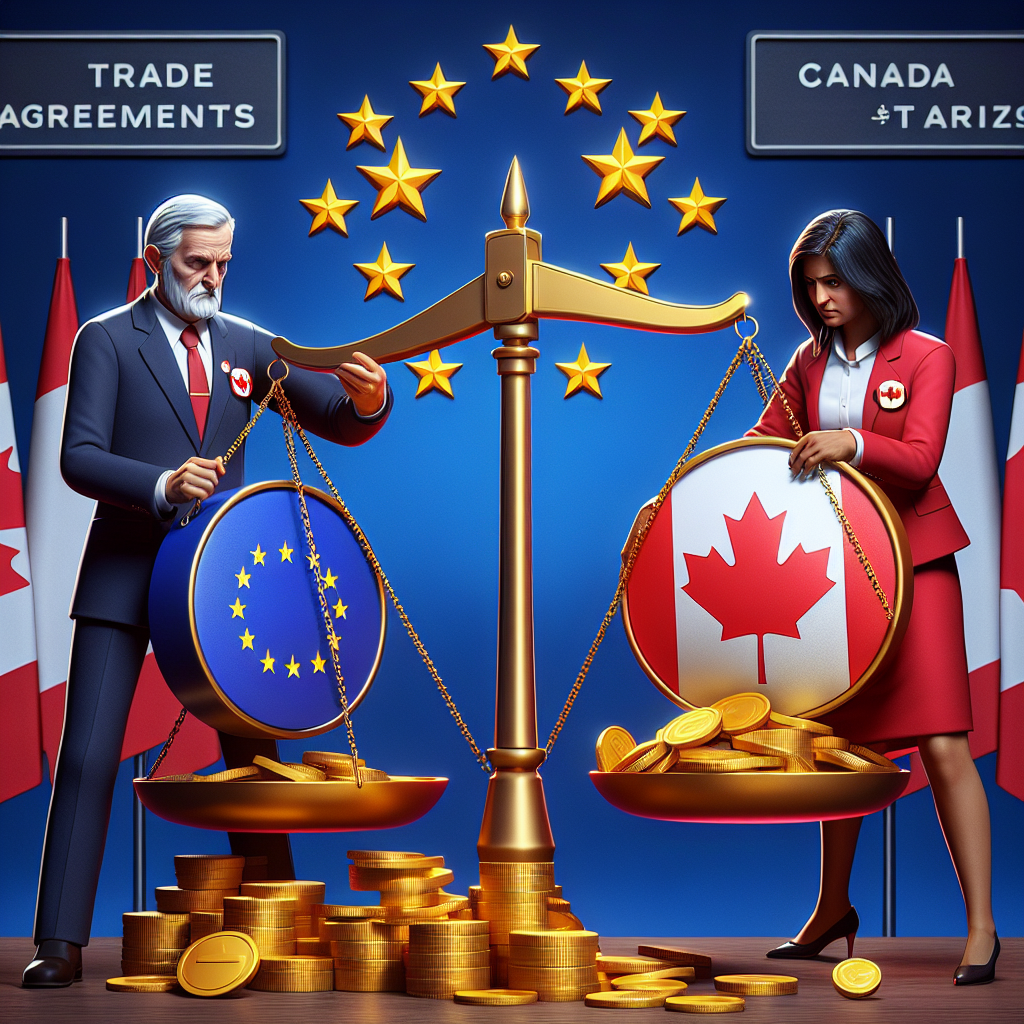Title: EU and Canada Counter US Tariffs: The Trade War Heats Up
Introduction
The global trade landscape took a sharp turn when the US government imposed a hefty 25% tariff on steel and aluminum imports. The reverberations were felt across international markets as two economic powerhouses, the European Union (EU) and Canada, swiftly retaliated with countermeasures. This sudden escalation of tariffs has plunged these nations into an intense trade dispute that could have far-reaching consequences for industries, economies, and consumers around the globe.
With tensions running high, many are left questioning the long-term implications of this trade war. Could it reshape international trade dynamics permanently, or is it a temporary standoff between global leaders? Let’s delve deeper into this unfolding situation.
The Origins of the US Tariffs: A Bold Move or Risky Gamble?
To fully understand the trade war, we must revisit the catalyst: the US administration’s decision to impose a 25% tariff on steel and aluminum imports. Citing threats to national security and the need to rebuild the domestic manufacturing sector, the Trump administration introduced these measures as a step toward protecting American industries from foreign competition.
However, this move also carried significant risks. Major exporting nations, such as those in the EU and Canada, saw this as an unfair economic attack and were quick to respond. In international trade, retaliation is rarely off the table. As expected, the introduction of US tariffs created a domino effect that escalated tensions rather than providing solutions.
EU and Canada’s Countermeasures: Hitting the US Where It Hurts
The EU and Canada wasted no time in striking back. Hours after the tariffs were announced, these global players introduced their own retaliatory tariffs, strategically targeting American exports. These measures were designed to inflict maximum political and economic pressure.
Why Target Specific American Products?
Retaliatory tariffs from the EU and Canada primarily targeted US goods with symbolic and economic importance, such as bourbon whiskey, motorcycles, denim, and agricultural products. By focusing on sectors critical to US political strongholds, they aimed to pressure American policymakers to reconsider their stance.
For instance:
- Canada imposed billions of dollars in duties on steel, aluminum, and finished products originating from the US.
- The EU identified iconic American goods, such as Harley-Davidson motorcycles and major agricultural exports, as key targets to hit where it would hurt politically.
The balanced yet strategic targeting reveals one thing: the EU and Canada are not just economic allies but skilled negotiators who understand how to leverage the global market to their advantage.
The Impact on US Consumers and Businesses
Trade wars rarely come without a cost, and the consequences are already rippling through the US economy.
- Rising Prices for Consumers: As tariffs increase the overall cost of imported goods, businesses often pass these expenses onto their customers. Everyday goods such as cars, appliances, and food items are likely to become more expensive, squeezing the average American’s wallet.
- Disruption in Supply Chains: Industries like automobile manufacturing, which rely heavily on imported steel and aluminum, are experiencing production delays and price hikes.
- Job Market Uncertainty: While the tariffs aim to protect domestic jobs, they could inadvertently lead to layoffs in export-dependent sectors due to reduced global demand.
The question remains: are the tariffs helping or harming the US economy in the long run? Many critics, including economists and citizens, have begun questioning the administration’s approach toward economic policy and trade.
The International Repercussions
Beyond the US, the fallout from this trade war extends to global markets. The increasing uncertainty has led to:
- Market Volatility: Financial markets are responding unpredictably to each new tariff announcement, creating unease among investors.
- Worsening Trade Relations: Global trade partners are now warier of US policies, potentially weakening diplomatic ties in the future.
- A Shift in Alliances: The trade war is fostering closer commercial relationships between other economic players, such as the EU and Asian nations, potentially isolating the US in the long term.
Conclusion
As the trade war between the US, EU, and Canada intensifies, the world watches with bated breath. The short-term impact on industries and consumers is already evident, but the long-term implications could be even more profound. Trade wars do not have clear winners; rather, they often leave economic scars on all parties involved.
In these uncertain times, it’s vital for governments to prioritize collaborative solutions over escalatory tactics. Without dialogue and diplomacy, the trade war risks spiraling into a larger economic crisis affecting not just these nations, but global markets.
The question is not whether anyone will “win” this trade war, but whether anyone will survive it unscathed.
Frequently Asked Questions (FAQs)
1. Why did the US impose tariffs on steel and aluminum imports?
The US government justified the tariffs by citing national security concerns and the need to protect domestic manufacturing industries from foreign competition.
2. How have the EU and Canada responded to the US tariffs?
The EU and Canada imposed retaliatory tariffs on US goods, strategically targeting iconic American products like bourbon whiskey, motorcycles, and agricultural exports.
3. What are the potential consequences of this trade war?
Key consequences include increased consumer prices, economic uncertainty, disruptions in supply chains, and weaker international trade relationships.
4. Could a trade war between these nations have global effects?
Yes, the trade war is already causing market volatility and increased tensions in global trade dynamics, potentially affecting economies worldwide.
5. How can this trade war be resolved?
A resolution will likely require extensive negotiations, compromise, and a commitment from all parties to prioritize mutual economic stability over political agendas.
Relevant Tags
#TradeWar #USTariffs #EUCanadaResponse #SteelAndAluminum #GlobalEconomy #EconomicPolicy #TariffRetaliation
Meta Description
Discover how the EU and Canada are retaliating against US steel and aluminum tariffs, the impact on consumers, and what this trade war means for the global economy.
https://bitecanvas.com/2025/03/13/us-tariffs-on-steel-and-aluminum-spark-global-trade-concerns/
